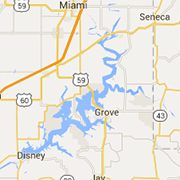Power for Progress: Hot stays out, cool stays in

Keeping the cool out and the hot in
We typically think of weatherizing our homes before the cold weather arrives. However, during an Oklahoma summer, it is also important to seal those gaps and cracks. This week, GRDA passes along some weatherization tips that may help keep the hot air outside of your home.
Power for Progress …
A weekly column from the Grand River Dam Authority
Hot stays out, cool stays in
We typically think of weatherizing our homes during the winter season, when cold and blustery Oklahoma winds can sneak in through cracks and gaps around doors and windows. However, when the temperature nears triple digits in the mist of summer, it is also important to have all the cracks sealed, to help ensure that not only does the hot air stay out, but that the cool air stays in. This week, the Grand River Dam Authority passes along a few tips from energy.gov that you may find helpful.
- First, we always think about caulking and weatherstripping around doors and windows that leak air, but it is also important to seal leaks where plumbing, ducting and electric wiring comes through walls, floors, ceilings, and soffits over cabinets.
- Install foam gaskets behind outlets and switch plates on walls.
- Inspect dirty spots on any visual insulation for air leaks and mold. Seal leaks with low-expansion spray foam made for this purpose and install house flashing if needed.
- Look for dirty spots on your ceiling paint and carpet, which may indicate air leaks at interior wall/ceiling joints and wall/floor joists and caulk them.
- Check your dryer vent to be sure it is not blocked. This will save energy and may prevent a fire.
- Replace exterior door bottoms and thresholds with ones that have pliable sealing gaskets.
- Use foam sealant on larger gaps around windows, baseboards, and other places where air may leak out.
- Consider hiring an energy assessor or other weatherization expert to test your home for air tightness.
These are just a few tips that can help keep your house properly sealed during all seasons of the year. Your friends at GRDA hope you have a great summer!
GRDA is Oklahoma’s largest public power electric utility; fully funded by revenues from electric and water sales instead of taxes. Each day, GRDA strives to be an “Oklahoma agency of excellence” by focusing on the 5 E’s: electricity, economic development, environmental stewardship, employees, and efficiency.






